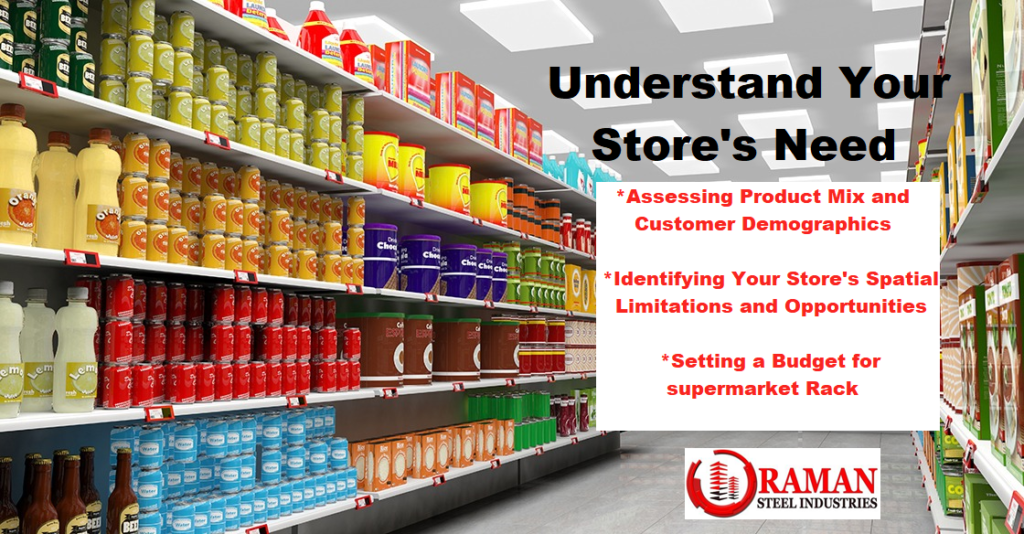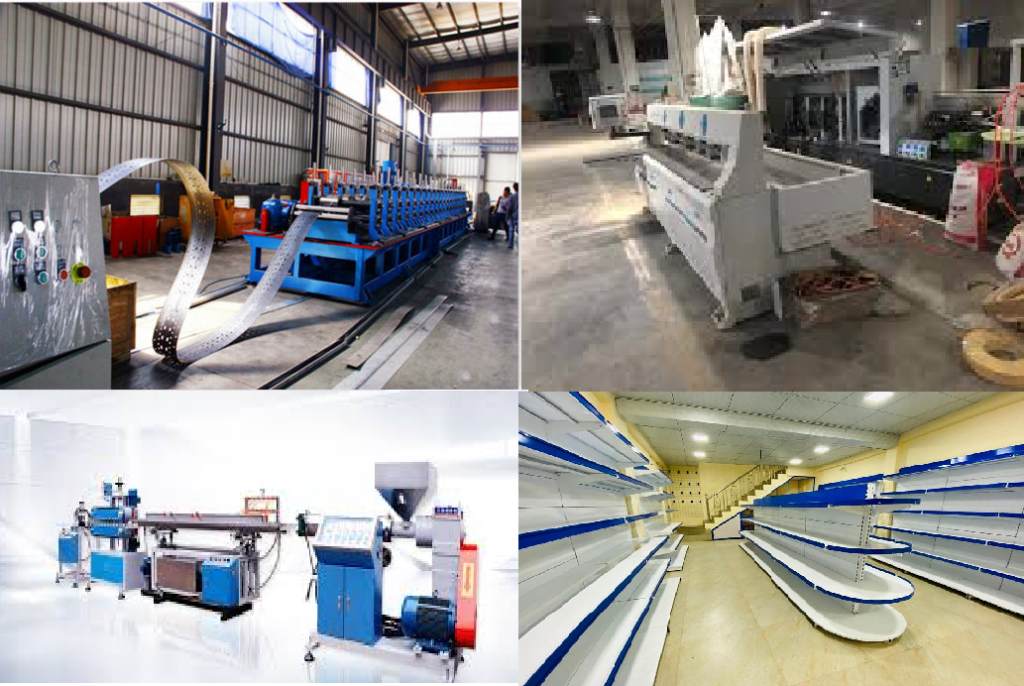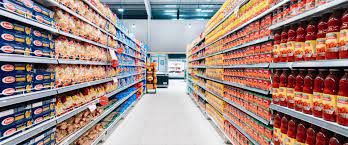
Chapter 1: Introduction to Supermarket Racks
• The role of supermarket racks in store layout and product display
• The benefits of using high-quality supermarket racks
• An overview of the different types of racks available
Chapter 2: Understanding Your Store’s Needs
• Assessing your store’s product mix and customer demographics
• Identifying your store’s spatial limitations and opportunities
• Setting a budget for supermarket rack purchases
Chapter 3: Types of Supermarket Racks
• Gondola racks: their versatility and ability to create a versatile store layout
• Wall-mounted racks: maximizing available wall space and creating an organized, eye-catching display
• End-cap racks: using high-traffic areas to highlight specific products and promotions
• Island racks: creating an immersive shopping experience and increasing the perceived value of your products
Chapter 4: Materials and Construction
• The different materials used in supermarket racks and their benefits
• Understanding the importance of rack durability and load capacity
• Proper maintenance and care of supermarket racks to ensure long-term performance
Chapter 5: Design and Layout
• Tips for creating an appealing and organized rack display
• Understanding the importance of color, lighting, and signage
• Optimizing your store’s layout for customer flow and ease of shopping
Chapter 6: Installation and Set-Up
• Choosing the right tools and equipment for rack installation
• Setting up and anchoring your racks for safety and stability
• Tips for efficiently stocking and organizing your products on the racks
Chapter 7: Maintenance and Upkeep
• Regular maintenance and cleaning routines to keep your racks looking their best
• Troubleshooting common rack issues and how to address them
• Repair and replacement options for damaged racks
Chapter 8: Conclusion
• Summarizing the key points of the book
• Highlighting the benefits of investing in high-quality supermarket racks
• Encouraging ongoing education and learning about supermarket rack best practices.
Chapter 1: Introduction to Supermarket Display Racks

Supermarket racks are a crucial component of every retail establishment because they offer an area for the attractive and ordered display of goods. The function of supermarket racks in store design and product display, the advantages of employing high-quality racks, and an overview of the various types of racks available are all covered in this chapter.
The role of supermarket display racks in store layout and product display
Supermarket racks are essential to the overall design of a business because they direct consumers around the area and display products in a lovely and practical way. Racks can be strategically arranged and organized to improve the shopping experience for customers, make it simple for them to discover what they’re searching for, and possibly even boost sales.
Gondola racks, for example, are a common option for supermarket layouts since they are adaptable and simple to adjust to match a variety of product types and sizes. These racks are frequently positioned in the middle of the store, creating a sort of “aisle” that patrons may walk along while seeing merchandise on both sides.
Wall-mounted racks are a popular alternative since they make the most of available wall space and produce a well-organized display. These racks may be altered to fit a range of product sizes and varieties, and they can be placed in a number of different ways to produce distinctive and eye-catching displays.
The Benefits of Using High-Quality Supermarket Racks
Using high-quality supermarket racks can offer a range of benefits to retailers. For one, these racks are typically more durable and long-lasting than lower-quality options, meaning that they can provide a more reliable and consistent display over time. Additionally, high-quality racks are often more customizable, allowing retailers to create unique and appealing displays that are tailored to their specific product mix and customer demographics.
Furthermore, high-quality racks can be easier to maintain and clean, reducing the amount of time and resources needed to keep them looking their best. Finally, investing in high-quality racks can help to increase customer confidence in a retailer, as customers are likely to perceive the quality of the racks as reflective of the quality of the products being sold.
An Overview of the Different Types of Racks Available
There are many different types of supermarket racks available, each with its own unique features and benefits. Some of the most popular types include:
- Gondola racks: These versatile racks are typically double-sided and can be customized to fit a range of product types and sizes. They are often used to create a central “aisle” in a store and can be easily moved and reconfigured as needed.
- Wall-mounted racks: These racks are mounted to a store’s walls and are ideal for maximizing available wall space. They can be customized to fit a range of product types and sizes and can be arranged in a variety of configurations to create unique and visually appealing displays.
- End-cap racks: These racks are placed at the end of aisles or in other high-traffic areas and are used to highlight specific products or promotions. They are often customized to fit the products being promoted and can be a highly effective way to increase sales and customer engagement.
- Island racks: These racks are freestanding and are typically placed in the center of a store to create an immersive shopping experience. They are often used to display high-end or specialty products and can increase the perceived value of the products being sold.
Overall, understanding the role of supermarket racks in store layout and product display, the benefits of using high-quality racks, and the different types of racks available is essential for any retailer looking to create an effective and appealing store layout. In the following chapters, we will explore each of these topics in more detail, providing tips and strategies for choosing the right racks for your store and creating a successful retail environment.
Chapter 2: Understanding Your Store’s Needs for Choosing Perfect Display Racks

In order to effectively plan and optimize your supermarket or retail store’s layout and shelving, it is important to first understand your store’s specific needs and limitations. This chapter will cover key areas to consider when assessing your store’s needs, including product mix, customer demographics, spatial limitations, and budget for rack purchases.
Assessing Your Store’s Product Mix and Customer Demographics
The first step in understanding your store’s needs is to assess your product mix and customer demographics. This includes understanding the types of products you sell and who your customers are. Analyzing your sales data can help you identify which products are selling well and which ones are not. This information can be used to determine the optimal shelving and layout for your store.
You should also take into account your customer demographics. Understanding who your customers are and what their preferences are will help you tailor your product mix and layout to meet their needs. For example, if your store serves a large elderly population, you may want to consider placing popular items at eye-level to make them more accessible.
Identifying Your Store’s Spatial Limitations and Opportunities
Another key area to consider when understanding your store’s needs is its spatial limitations and opportunities. This includes analyzing the size and layout of your store, as well as any existing shelving and displays.
When assessing your store’s layout, it is important to consider the flow of traffic and how customers move through your store. You should also consider the placement of aisles and shelving units to ensure that customers can easily navigate the store and find what they are looking for.
In addition, you should consider any unique spatial opportunities that your store may have. For example, if your store has high ceilings, you may want to consider installing tall shelves to maximize your storage capacity.
Setting a Budget for Supermarket Rack Purchases
Finally, when understanding your store’s needs, it is important to set a budget for supermarket rack purchases. This includes both the initial cost of purchasing the racks and ongoing maintenance costs.
When setting your budget, it is important to consider the quality of the racks you are purchasing. While it may be tempting to opt for cheaper options, investing in high-quality racks can ultimately save you money in the long run by reducing the need for frequent repairs and replacements.
In addition, you should consider the specific needs of your store when choosing racks. This includes the size and weight of the products you sell, as well as any unique spatial limitations or opportunities that your store may have.
Overall, understanding your store’s needs is an important first step in optimizing your supermarket or retail store’s layout and shelving. By assessing your product mix and customer demographics, identifying your store’s spatial limitations and opportunities, and setting a budget for supermarket rack purchases, you can create a more effective and efficient store layout that meets the needs of both your business and your customers.
Chapter 3: Types of Supermarket Racks
Supermarkets are busy places, with a wide variety of products to be displayed and organized. Choosing the right type of supermarket rack can make a significant difference in the effectiveness of your store layout and in attracting customers. In this chapter, we’ll take a closer look at the different types of supermarket racks available and how they can be used to create an optimal shopping experience for customers.

Gondola Racks
Gondola racks are among the most common and versatile types of supermarket racks. They are free-standing, double-sided units that can be arranged to create aisles or zones within a store. Gondola racks are adjustable in height and depth, allowing for flexibility in the arrangement of products and display shelves. This flexibility makes gondola racks ideal for creating a store layout that highlights specific products or categories while maximizing available floor space.
Wall-Mounted Racks
Wall-mounted racks are an excellent choice for maximizing available wall space in a supermarket. They can be used to create an organized and eye-catching display of products, and they can also be customized to match the store’s branding and decor. Wall-mounted racks are typically used for smaller, lighter items, such as snacks, beverages, and personal care products. They are also ideal for creating a display that complements a particular theme or season, such as a display of holiday-themed treats or summer beach gear.
End-Cap Racks
End-cap racks are located at the end of an aisle, where they can draw attention to specific products or promotions. They are typically used to showcase items that are on sale or to highlight new products. End-cap racks can be customized to match the store’s branding and can be designed to be easily accessible from both sides of the aisle. These racks are particularly effective in high-traffic areas where customers are likely to notice them.
Island Racks
Island racks are a type of supermarket rack that creates an immersive shopping experience for customers. These racks are free-standing units that can be arranged in the center of a store to create a zone of products or a theme. They are typically used to showcase premium or high-value items, such as organic foods, wine, or specialty cheeses. Island racks are designed to be visually appealing and can help to increase the perceived value of the products being sold.
In conclusion, the right type of supermarket rack can make a significant difference in the effectiveness of a store’s layout and in attracting customers. Gondola racks are versatile and can be arranged in various configurations to maximize available floor space. Wall-mounted racks make effective use of available wall space, creating an organized and eye-catching display. End-cap racks are located in high-traffic areas, where they can draw attention to specific products or promotions. Finally, island racks create an immersive shopping experience that increases the perceived value of premium products. By using the right type of supermarket rack in the right location, stores can create a shopping experience that is both organized and visually appealing, resulting in increased sales and customer satisfaction.
GET IN TOUCH
Schedule a Visit
Chapter 4: Materials and Construction For Supermarket Racks
When it comes to designing and constructing supermarket racks, the choice of materials plays a critical role in determining the overall quality and durability of the racks. This chapter will discuss the different materials commonly used in supermarket racks and their benefits, as well as the importance of rack durability and load capacity. Additionally, we’ll explore proper maintenance and care of supermarket racks to ensure long-term performance.

Materials Used in Supermarket Racks and Their Benefits:
Steel: This is one of the most commonly used materials in supermarket racks due to its high strength and durability. Steel racks can withstand heavy loads and are resistant to wear and tear. They also provide excellent support for shelves and other components, making them a popular choice for many retailers.
Aluminum: This lightweight material is another popular choice for supermarket racks. Aluminum racks are strong and durable, yet significantly lighter than steel racks. This makes them easy to move around and adjust, making them ideal for retailers who need to rearrange their racks frequently.
Plastic: Plastic racks are ideal for retailers who need lightweight and easy-to-clean shelves. They are not as strong as steel or aluminum racks, but they are still capable of handling light to moderate loads. Plastic racks are also resistant to corrosion and rust, making them suitable for use in humid environments.
Importance of Rack Durability and Load Capacity:
When designing and constructing supermarket racks, it’s essential to consider the load capacity and durability of the racks. The load capacity refers to the maximum weight that a rack can support, while durability refers to how long a rack can withstand heavy use without deteriorating.
Inadequate load capacity can lead to the collapse of racks, which can cause injury to customers and employees and damage to merchandise. Therefore, it’s crucial to choose materials that can support the weight of the merchandise and other items stored on the racks.
Proper Maintenance and Care of Supermarket Racks:
Proper maintenance and care of supermarket racks are essential for ensuring long-term performance and durability. Retailers should perform regular inspections of their racks to identify any signs of wear and tear. If any issues are detected, repairs should be made immediately to prevent further damage.
Regular cleaning is also critical for maintaining the appearance and hygiene of supermarket racks. Dust, dirt, and other debris can accumulate on the shelves and other components, which can attract pests and pose a health hazard. Therefore, it’s essential to clean the racks regularly using appropriate cleaning agents and methods.
Conclusion:
Supermarket racks are critical components of any retail environment, and the choice of materials used in their construction can have a significant impact on their performance and durability. Understanding the benefits of different materials, load capacity, and proper maintenance and care can help retailers choose the best supermarket racks for their specific needs and ensure they last for years to come.
Chapter 5: Design and Layout of your Supermarket Store

The design and layout of your supermarket racks can make a big impact on how customers perceive and interact with your store. In this chapter, we’ll explore tips for creating an appealing and organized rack display, understanding the importance of color, lighting, and signage, and optimizing your store’s layout for customer flow and ease of shopping.
Creating an Appealing and Organized Rack Display

The first step in designing your supermarket racks is to consider how you want your products to be
presented to customers. A visually appealing and organized display can help to attract customers and encourage them to make purchases.
One effective way to create an organized display is to group similar products together. For example, you might want to group all of your breakfast cereals together, or all of your canned goods in one section. This not only makes it easier for customers to find what they’re looking for, but it also helps to create a cohesive look throughout your store.
Another important consideration when creating an organized rack display is the spacing between products. It’s important to make sure that your products aren’t too crowded together, as this can make it difficult for customers to browse and select items. At the same time, you don’t want to leave too much empty space, as this can make your store look unkempt and unorganized.
Understanding the Importance of Color, Lighting, and Signage
Color, lighting, and signage are all important elements of your supermarket rack design. Choosing the right colors can help to create a welcoming and inviting atmosphere, while also helping to differentiate between different types of products.
Lighting is also a crucial element of your supermarket rack design. Good lighting can help to highlight your products and make them look more appealing, while also making it easier for customers to see what they’re looking for. You may want to consider using different types of lighting in different areas of your store to create different moods and highlight different products.
Signage is another important element of your supermarket rack design. Clear and informative signage can help customers quickly and easily find what they’re looking for, while also highlighting promotions and special offers. You may want to consider using different types of signage, such as hanging signs, shelf labels, and floor signs, to create a cohesive and informative display.
Optimizing Your Store’s Layout for Customer Flow and Ease of Shopping
Finally, it’s important to consider the overall layout of your store when designing your supermarket racks. A well-designed layout can help to guide customers through your store in a logical and intuitive way, making it easier for them to find what they’re looking for and encouraging them to make purchases.
One effective way to optimize your store’s layout is to create different zones for different types of products. For example, you might have a zone for fresh produce, another for frozen foods, and another for household cleaning products. This not only makes it easier for customers to find what they’re looking for, but it also helps to create a more organized and intuitive layout.
Another important consideration when designing your store’s layout is the placement of your checkout area. You may want to consider placing your checkout area near the entrance or exit of your store, as this can make it easier for customers to find and help to minimize congestion during peak hours.
By taking the time to carefully consider the design and layout of your supermarket racks, you can create a welcoming and organized shopping environment that encourages customers to make purchases and return to your store again and again.
Chapter 6: Installation and Set-Up of Display Racks
After selecting the appropriate supermarket racks, the next step is to install and set them up correctly. Proper installation and set-up are crucial for ensuring the safety and stability of the racks. This chapter will cover the important aspects of rack installation and set-up, including choosing the right tools and equipment, anchoring the racks for safety, and tips for efficiently stocking and organizing products on the racks.

Choosing the Right Tools and Equipment for Rack Installation:
Before beginning the installation process, it’s important to gather all the necessary tools and equipment. These may include a drill, screws, a level, a measuring tape, and a rubber mallet. It’s also essential to ensure that the tools are in good condition and appropriate for the job.
- Setting Up and Anchoring Your Racks for Safety and Stability:
The first step in setting up your racks is to ensure that the floor is level. Uneven surfaces can cause instability in the racks, leading to accidents and damage to products. Once the floor is level, anchor the racks to the floor or walls using appropriate hardware and anchors. This will prevent the racks from tipping over or collapsing.
- Tips for Efficiently Stocking and Organizing Products on the Racks:
Proper stocking and organization of products on supermarket racks can help improve the shopping experience for customers and increase sales. Here are some tips for efficient stocking and organization:
- Use shelves that are appropriate for the size and weight of the products. Heavier products should be placed on lower shelves to prevent overloading the upper shelves.
- Arrange products by category or theme to make it easier for customers to find what they are looking for.
- Use clear signage to indicate product location and price.
- Keep popular products at eye level to increase visibility and accessibility.
- Regularly restock products to ensure that shelves are always full and tidy.
Conclusion:
Installing and setting up supermarket racks is a critical step in creating an effective retail environment. Choosing the right tools and equipment, anchoring the racks for safety and stability, and efficiently stocking and organizing products on the racks are essential for a successful retail experience. By following these tips, retailers can create a safe and efficient shopping experience for their customers.
Chapter 7: Maintenance and Upkeep

Proper maintenance and upkeep of supermarket racks are critical to ensure their longevity and optimal performance. Neglecting maintenance can lead to rack damage and deterioration, which can result in safety hazards and costly replacements. This chapter will provide insights into regular maintenance and cleaning routines to keep your racks looking their best, troubleshooting common rack issues and how to address them, and repair and replacement options for damaged racks.
Regular Maintenance and Cleaning Routines:
- Regular Inspections: Routine inspections are critical for identifying any damage or wear and tear on your supermarket racks. Inspect all components of your racks, including the shelves, brackets, and frames, for signs of damage. Pay attention to loose bolts or screws, bent frames, or shelves that are sagging or bowing.
- Cleaning: Regular cleaning of your racks is crucial to maintain hygiene and prolong the life of your racks. Dust and debris can accumulate on your shelves and frames, making your racks look unappealing and unclean. Use appropriate cleaning agents and techniques to clean your racks thoroughly. Avoid using abrasive cleaning agents or materials that can scratch or damage the surface of your racks.
- Lubrication: Moving parts of your supermarket racks, such as wheels and hinges, need to be lubricated regularly to keep them functioning smoothly. Use a high-quality lubricant to avoid damaging the moving parts of your racks.
- Troubleshooting Common Rack Issues and How to Address Them: Shelves Sagging or Bowing: Overloading your shelves with heavy items can cause them to sag or bow. To prevent this, make sure to distribute the weight evenly across your shelves. If your shelves are already sagging, consider using additional support, such as brackets or reinforcements.
- Loose Bolts or Screws: Regularly check for loose bolts or screws on your racks. Tighten them immediately to prevent further damage or potential safety hazards.
- Bent Frames: Bent frames can cause your racks to be unstable and pose a safety hazard. If you notice any bent frames, replace them immediately.
Repair and Replacement Options for Damaged Racks:
- Repair: Some minor damages, such as scratches or dents, can be repaired using specialized tools and techniques. It’s essential to address these damages as soon as possible to prevent further deterioration and potential safety hazards.
- Replacement: Severe damages that affect the structural integrity of your racks require immediate replacement. It’s essential to have a maintenance plan that includes regular inspections to identify potential damage early.
Conclusion:
Regular maintenance and upkeep of your supermarket racks are critical to ensure their longevity and optimal performance. Routine inspections, cleaning, and lubrication are essential maintenance practices to keep your racks looking their best. Troubleshooting common rack issues and addressing them promptly can prevent further damage and potential safety hazards. Finally, repair or replacement options for damaged racks should be determined based on the severity of the damage. A well-maintained and properly functioning supermarket rack system can help improve your store’s functionality, efficiency, and overall customer experience.
Chapter 8: Conclusion
In this book, we’ve explored the world of supermarket racks, from the different types of racks available to their design, installation, and upkeep. By now, you should have a solid understanding of what goes into choosing the right racks for your store, as well as the benefits of investing in high-quality racks.
To summarize, here are some of the key points covered in this book:
- Supermarket racks play a critical role in store layout and product display, making them a key consideration for any store owner or manager.
- By understanding your store’s needs, you can select the right type of rack to best showcase your products and cater to your customers.
- Materials and construction are important factors to consider when choosing supermarket racks, as they can impact durability and load capacity.
- Proper design and layout can help you create an organized and appealing rack display, which can encourage customers to shop longer and purchase more.
- Installation and set-up are crucial steps in ensuring the safety and stability of your racks, as well as the efficient stocking and organization of your products.
- Maintenance and upkeep are important for keeping your racks looking their best and functioning properly, as well as ensuring the safety of your customers.
Investing in high-quality supermarket racks can offer a range of benefits for your store, including increased sales, improved customer experience, and a more organized and efficient store layout. By choosing the right racks for your store and taking care of them properly, you can set yourself up for long-term success.
Finally, we encourage you to continue learning about supermarket rack best practices, as the industry is constantly evolving and changing. By staying up-to-date on the latest trends and innovations, you can continue to optimize your store’s layout and product display for the benefit of your customers and your business.


